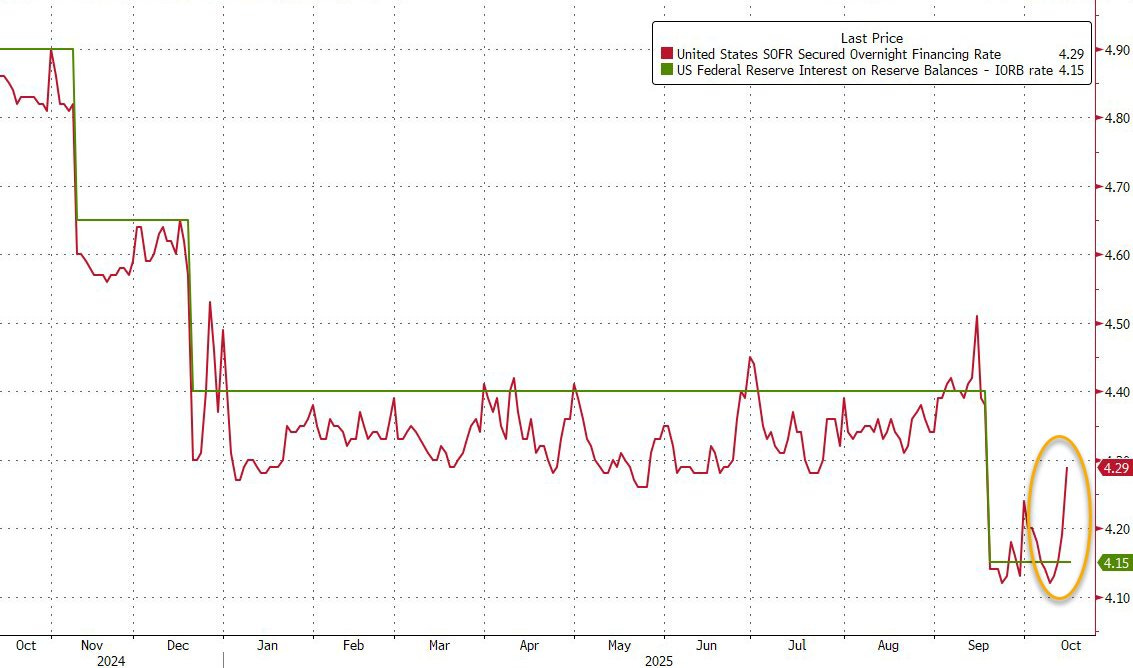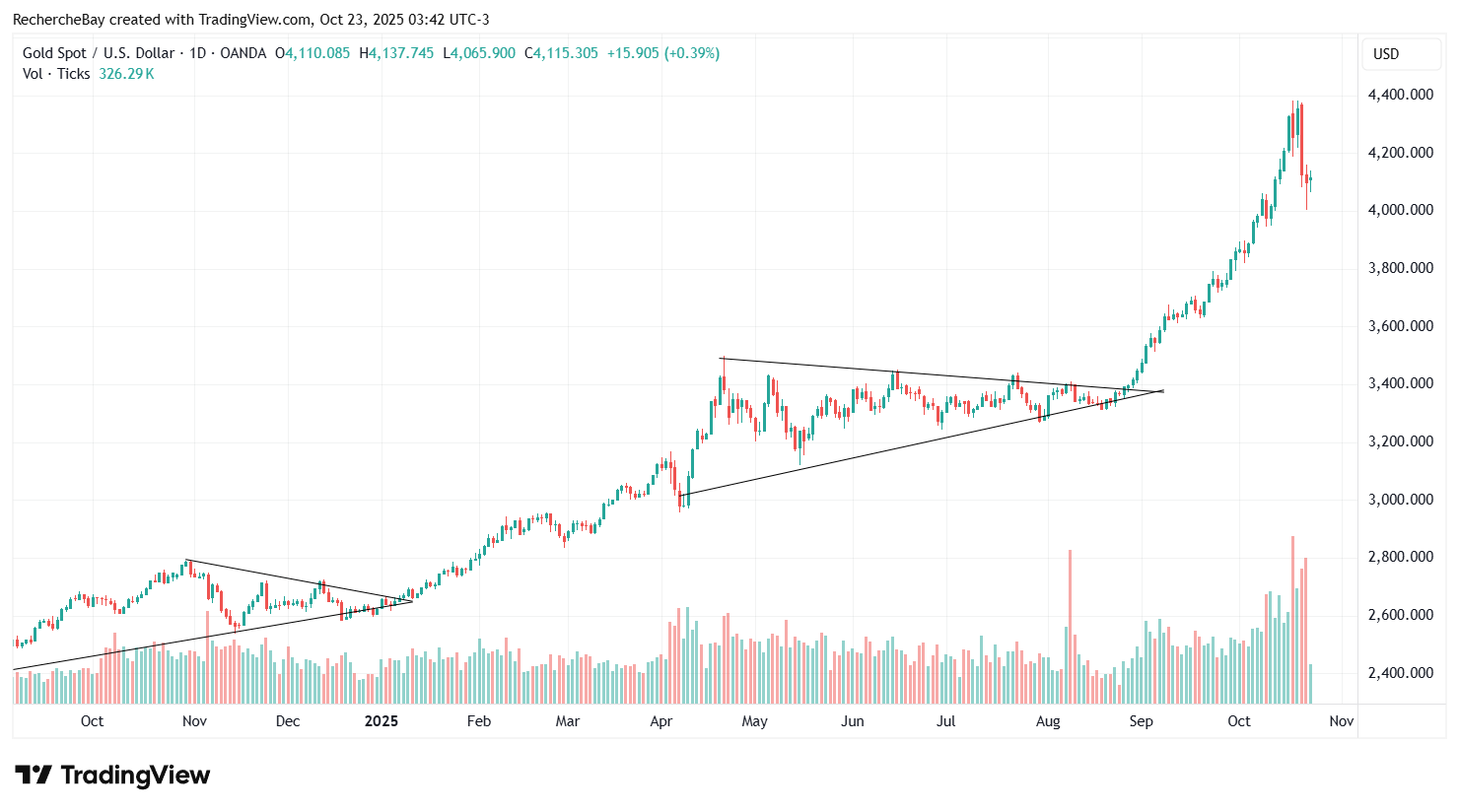The United States Is Entering A Collateral Crisis
This week, signs of financial tension became tangible.
On Wednesday, the US monetary system began to creak: the SOFR – the interbank financing rate guaranteed by Treasury bills – exceeded the Fed's discount rate, i.e., the emergency borrowing rate normally reserved for banks in distress. In short, it is now more expensive to borrow on the market than to knock directly on the Fed's door.
(Click on image to enlarge)

This phenomenon, which is extremely rare outside of times of crisis, signals one simple thing: cash is becoming scarce, even for solid institutions.
Contrary to what some commentators suggest, this surge in SOFR does not yet represent a collapse of shadow banking, but it may herald the first cracks.
Shadow banking refers to any activity that resembles banking – lending, borrowing, securitizing debt – but is not carried out by a bank. It includes private credit funds, leasing companies, fintech companies that lend to households, and securitization vehicles owned by insurers or funds. This parallel system does not receive deposits, does not benefit from public guarantees, and cannot refinance itself with the Fed. Instead, it depends entirely on the repo market and the cost of short-term financing to function.
However, it is precisely these channels that are breaking down.
For several weeks now, bankruptcies have been multiplying in the peripheral links of the US credit chain: First Brands and the auto lender TriColor have been accused of fraudulent lending practices; the financing company Kabbage, which specializes in loans to small and medium-sized businesses, has filed for bankruptcy; and several regional banks, such as Western Alliance and Zions Bancorporation, have acknowledged significant losses on loan portfolios sold to these off-balance-sheet entities. In other words, the risks that had been “shifted” out of the banking system are now coming back to haunt the balance sheets of traditional institutions.
This is where the link between SOFR and shadow banking becomes explosive.
The higher the cost of financing rises, the more these non-bank players – who live on credit – find themselves suffocated. They have to sell off their assets to raise cash, putting even more pressure on the market.
And this time, the US Treasury is adding its own layer of stress.
Massive Treasury auctions absorb tens, sometimes hundreds of billions of dollars in liquidity every week. Dealers, responsible for buying these securities on behalf of the market, have to borrow more and more cash to finance them. Their balance sheets are saturated, their leverage is climbing, and the cost of this financing is skyrocketing.
It's a vicious circle: the Treasury issues bonds to raise cash, but in doing so, it withdraws cash from the system.
On Wednesday, this tension suddenly materialized. Repo spreads widened, some desks struggled to raise leverage, and overnight rates took off. On Thursday, a new auction only amplified the pressure. And next week looks set to be even more difficult: the federal shutdown continues to delay Treasury payments, while the end-of-month fiscal deadline approaches – a period during which companies withdraw large amounts of cash from their accounts to pay taxes, exacerbating the contraction in bank reserves. With each passing day and each additional auction, cumulative tension builds in the system's plumbing.
The gold price reflects this tension in its own way. Since the beginning of the week, the yellow metal has been consolidating around $4,150 to $4,200 per ounce, with no sign of a breakout:
(Click on image to enlarge)

This decline does not reflect a lack of investor interest: it simply reflects the scarcity of dollars. When financing tightens, funds temporarily sell their most liquid positions – including gold – to meet margin calls. This is not a flight, it is a survival reflex: generating cash in a market where cash is becoming scarce.
Historically, these periods of consolidation in a stressful monetary environment always precede sharp recoveries. As soon as the Fed or the Treasury has to inject liquidity to prevent a repo freeze, gold will rebound, driven by the same logic as always: when the plumbing breaks, you reopen the valves.
Meanwhile, the global political scene is adding to the confusion. Donald Trump has promised a “historic meeting” with Xi Jinping next week in South Korea – an announcement widely reported by the US media without any confirmation from Beijing. This is clearly a diplomatic bluff, intended to maintain the illusion of dialogue, even though no timetable exists. And as if that weren't enough, Trump has threatened to impose 150% tariffs on Chinese imports. A thunderous figure, but one that is completely unenforceable: US customs systems would not be able to recalculate these taxes in a matter of days, freight forwarders would be paralyzed, and ports would be saturated. This threat is not a trade policy, it is a show of force – an open negotiation.
The markets have understood this well: the theater continues, but confidence is gradually eroding.
The SOFR is climbing, dealers are saturated, bankruptcies are piling up in shadow banking, the shutdown is dragging on, T-bills are piling up, and gold is breathing. The markets are still holding up, but they are on life support.
The real stress can now be seen in the SOFR, in the Repo, and in the shortness of breath of the dealers. We are not yet in a credit crisis, but we are already in a collateral crisis. And that's always where it all starts.
A credit crisis arises when borrowers can no longer repay their loans: defaults pile up, banks cut off lending, and the economy slows down.
This is exactly what happened in 2008, when over-indebted households stopped paying their mortgages, causing the securitized products that depended on them to fail.
A collateral crisis, on the other hand, occurs even before defaults: it affects the quality and availability of the guarantees that underpin credit. In other words, it is not yet the borrower who defaults, but the system that doubts the value of the collateral being exchanged.
In today's world, all financing is based on collateralized assets – Treasury bills, bonds, securitized loans.
When these assets become too numerous, too risky, or too illiquid, confidence erodes: lenders demand higher margins or refuse to lend altogether.
This is exactly what the rise of SOFR shows: cash is not disappearing, but it is circulating less easily because each player is becoming more demanding about the quality of the collateral they accept.
This mistrust is spreading silently.
A credit fund hesitates to roll over its positions; a bank refuses a repo deemed too risky; a dealer, saturated with T-bills, can no longer lend cash.
Nothing breaks down yet, but everything gets a little more jammed up every day.
This is the most dangerous phase, when the system still appears stable but real liquidity is evaporating.
In a credit crisis, fear is visible – bankruptcies multiply.
In a collateral crisis, it is silent – it is financing itself that freezes.
More By This Author:
What Does The Disruption Of The Silver Market Mean?
The Holders Of France's Debt Must Remain Secret, According To The Senate
Silver: “Reset” Underway In A Frozen Market
Disclosure: GoldBroker.com, all rights reserved.



